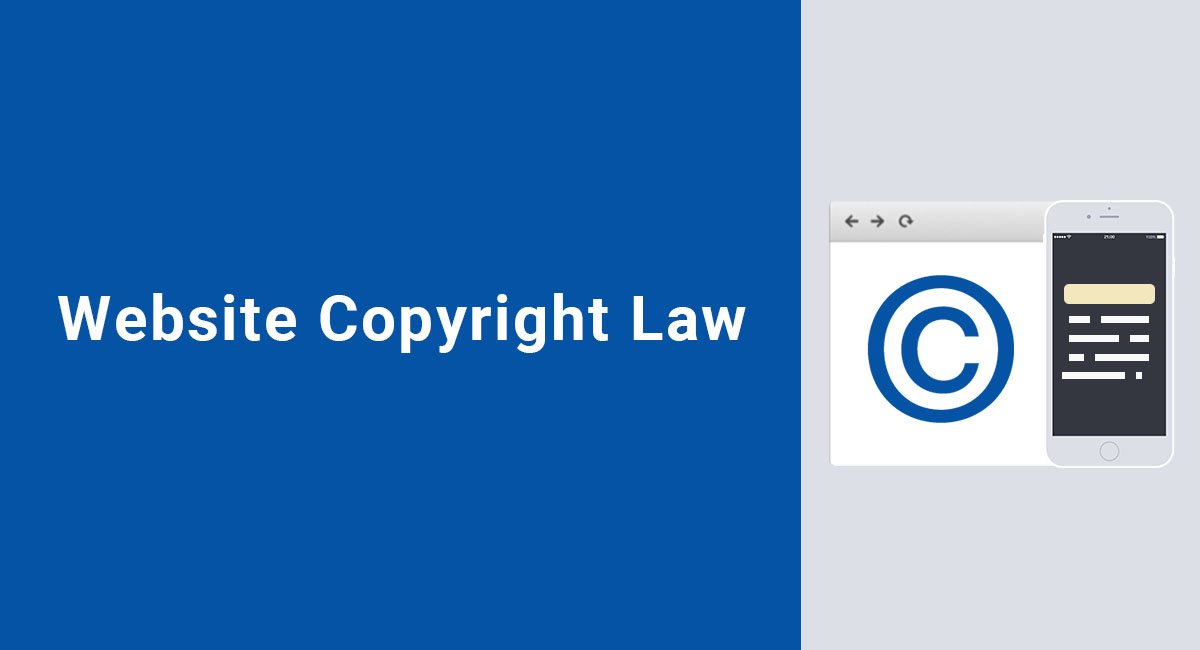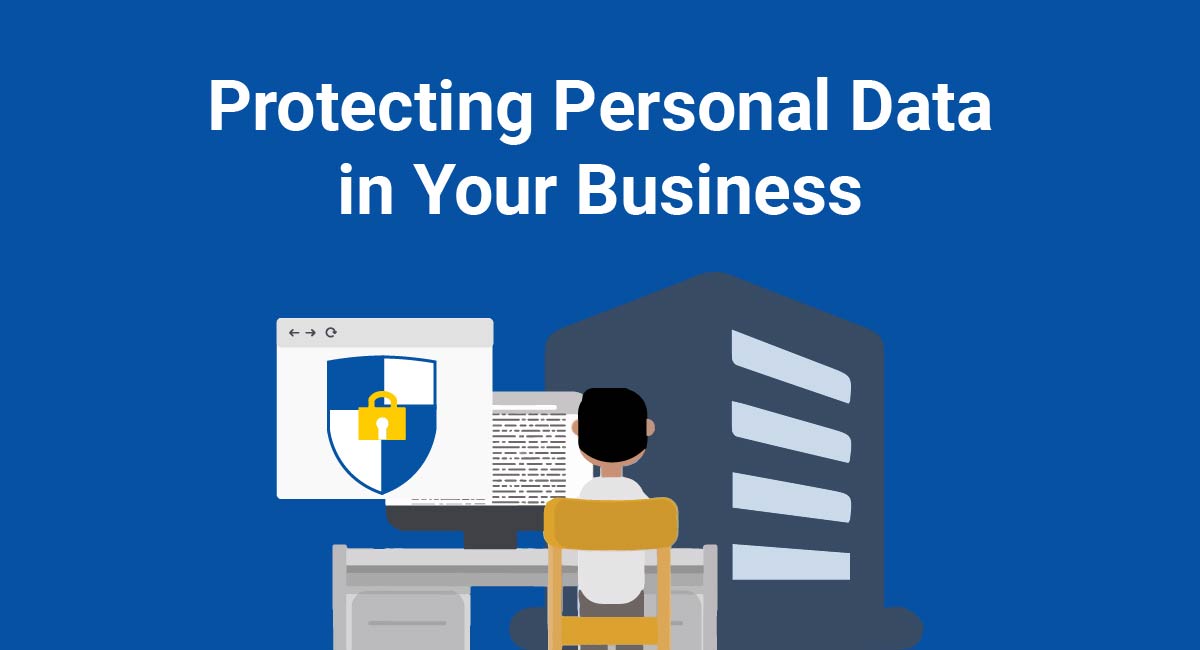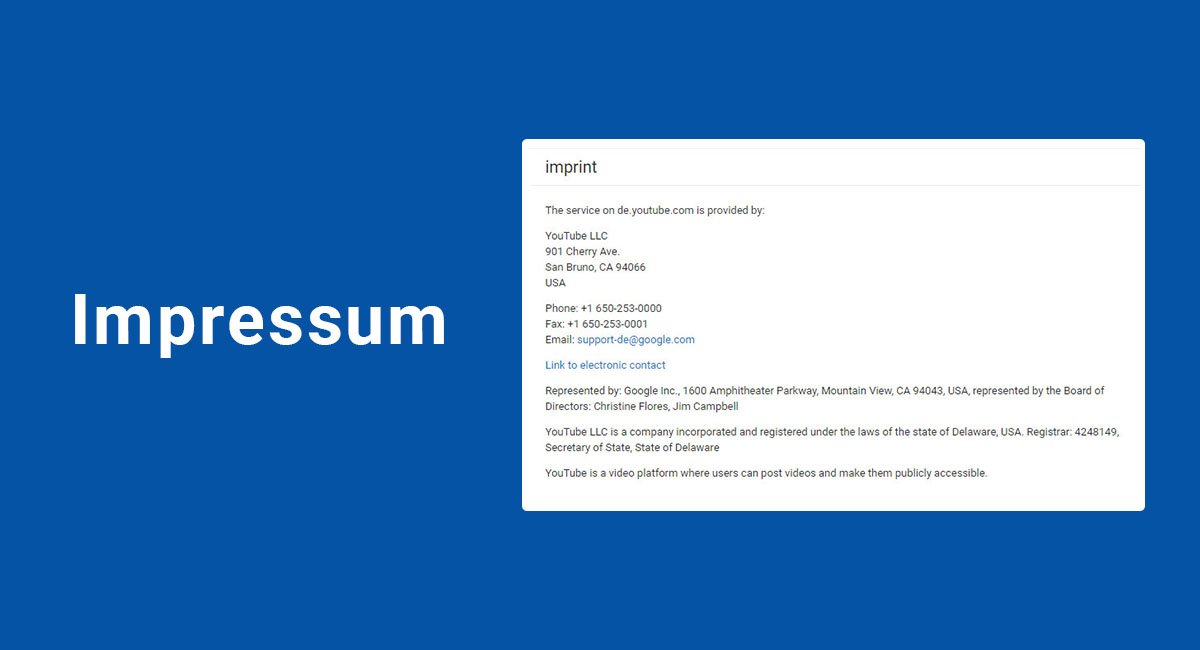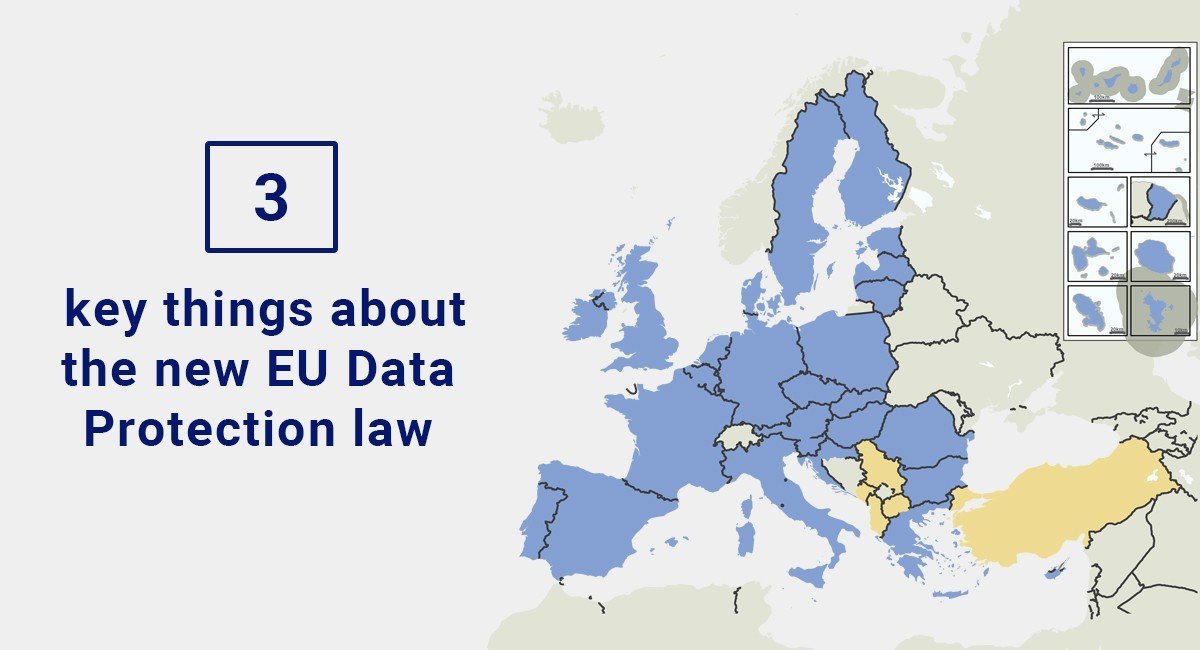The online world allows for the free flow of information, including text and graphics.
However, this accessibility leads to a common problem: Your online content, no matter its form, is easy for unscrupulous parties to steal and claim as their own.
You can avoid this scenario by taking advantage of the protections offered by copyright law.
- 1. Copyright law and websites
- 1.1. Specific laws
- 1.1.1. U.S.
- 1.1.2. U.K.
- 1.1.3. Australia
- 1.1.4. Canada
- 1.2. How it works
- 1.3. International reach
- 1.3.1. Berne Convention
- 1.3.2. Universal Copyright Convention
- 1.3.3. World Intellectual Property Organization
- 2. User-Generated Content and copyright protection
- 3. Infringement
- 4. Fair Use
- 5. Webpage Copyright Protection FAQ
- 5.1. What is a copyright?
- 5.2. Does copyright protection extend to my website?
- 5.3. Do I need to register every component of my website separately?
- 5.4. Does my website need a notice to be protected?
- 5.5. What are the relevant laws?
- 5.6. How do I secure this protection?
- 5.7. I am building a website in the United Kingdom. Do I have copyright protection in the United States?
- 5.8. Are there exceptions to copyright protection?
- 5.9. I hate forms! Why should I bother registering?
- 5.10. Someone copied my web page content! Now what do I do?
Copyright law and websites
Copyright refers to the legal protection of original works of authorship. This includes literary, written, dramatic, artistic, musical, and other types of creative expression.
It does not include industrial or technological inventions, although there are jurisdictions that consider computer software a creative work capable of copyright.
Sometimes copyright protection overlaps with other types of intellectual property. For example, an online game may contain storylines and music appropriate for copyright registration, but also contains processes that need protection under patent law.
Websites contain written material, graphics, business logos, and other visual and sound elements. This firmly categorizes them as copyrightable material.
Specific laws
Copyright protection laws are similar with few subtle differences. Here is an overview of the laws in major jurisdictions.
U.S.
The basis of copyright protection in the U.S. is the Copyright Act of 1976. It grants authors and artists the exclusive rights to reproduce, distribute, and display their works.
Websites fall under this protection because they contain creative elements like written content and images.
You enjoy copyright protection immediately at the time of creation but registration with the U.S. Copyright Office allows you to have a civil remedy if someone steals your work.
There are also additional statutory damages that you can only collect if you register your work and the infringement is especially egregious--like mass distribution that affects your reputation in the marketplace.
The only exception to this protection is works for hire. If you draft a website for another entity and the contract grants ownership of its elements to it, you do not enjoy copyright protection and your client can use the website material however they wish. Some independent developers maintain copyright ownership in their work, especially if the material involves substantial effort, like original photography, videos or even blog articles.
U.K.
The law in the U.K. is the Copyright, Designs and Patents Act 1988. It is similar to the U.S. law in that it protects original creations involving literary work, music, art, film, and sound.
A supplemental law, the Copyright (Computer Programs) Regulations 1992 extends protection to software, which is normally protected under laws and agencies unique from copyright.
Works are protected upon creation, meaning as soon as you post your website, you enjoy copyright protection. However, the U.K. Copyright Service highly recommends registration because websites are subject to abuse and that process allows a civil cause of action.
The U.K. law does not extend the same copyright protection to logos as the U.S. law. You will have to register any logos as a trademark.
Australia
Copyright law is set out in the Copyright Act 1968. Its legislative purpose was to encourage people to use their resources to create original material, especially those with cultural or educational value.
This law protects the same types of literary and creative works as other copyright law. It is specific in stating that ideas, concepts, styles, techniques, and data do not fall under copyright protection.
For example, an outline for a TV program would not be protected and if stolen and produced by someone other than the creator, there is no cause of action. However, a finished TV program is protected.
Copyright protection is automatic. Unlike the U.K. and U.S., Australia does not have a registration process so any disputes must be resolved in civil court.
Canada
The Copyright Act in Canada is enforced by the Intellectual Property Office. It is similar to the other laws described here in that it protects literary, musical, dramatic, and audio works.
It also has a registration process and all works are protected for the life of the creator plus an additional 50 years. Registering copyrights produces proof that you own the work and allows you additional civil remedies. Websites can be registered for protection in Canada and it's highly recommended that you do so.
How it works
As indicated, copyright protection is effective as soon as you post your website. To remind users of this protection, many websites add copyright notices to the footer.
Since new content on a website technically requires additional registration, many developers place a range of years on their website to cover all past and current content.
Focus@Will has this range and expands it as new years begin. You will see this change to 2012-2018 on or near January 1, 2018:

Developers who create sites for other entities may retain their copyright protections, especially if they maintain their own graphics libraries and staff copywriters. The website footer will have the contractor's name in these cases:

Developers who maintain their websites in-house create copyright notices with the company name and the current year:

There is no set template for copyright notices. They are actually not required in the first place--just a long-established habit. Developers use them for reassurance and a reminder to the world that the material is copyrighted rather than as a way to enhance legal rights.
Registration is recommended if you want civil remedies for copyright infringement. Websites are vulnerable because it is easy to copy online content and reuse it. If you do not want your proprietary creations being reproduced without your permission, look into registration.
No matter where you register, the process is basically the same:
- Search a database to be sure similar content is not already registered,
- Fill out a paper or online application,
- Pay a fee, then
- Wait to hear a decision from the copyright office. Most applications are approved.
There is no such thing as international registration so you will need to register separately in each country you desire this protection. Most laws allow foreign citizens to register their works, but it may be more work than necessary. International protection is available through conventions and treaties.
International reach
The U.S. Copyright Office is very good at sharing news of international copyright protection treaties and conventions. There are several that go into effect each year and they range from regional to international.
There are three major treaties and organizations for international copyright protection.
They include:
- Berne Convention
- Universal Copyright Convention
- World Intellectual Property Organization.
Berne Convention
The Berne Convention is formally known as the Berne Convention for the Protection of Literary and Artistic Works. Established originally in 1886, it advances three basic principles:
- Works protected in contracting states must be given the same protection in all other contracting states,
- Protection cannot be limited to registered works, and
- Works must remain protected for a minimum of 50 years after the creator's death
Here is an example of how protection under the Berne Convention works:
France offers copyright protection under Section One of the French Intellectual Property Code. However, it only allows registration of material to French citizens.
Technically, if it was not a contracting state under the Berne Convention, any American, British or other foreign website could be infringed without penalty. Since it is a part of this treaty, any work of art or website registered and protected in other member states must also remain protected in France.
There are 173 contracting states to the Berne Convention, including the U.S., Australia, Canada, U.K., and even developing nations like Uruguay, Rwanda, and Gambia. In fact, the Berne Convention offers resources to developing nations to help them create their own copyright protection policies so they can encourage educational and cultural arts.
Universal Copyright Convention
Maintained by the United Nations Educational, Scientific, and Cultural Organization (UNESCO), the Universal Copyright Convention (UCC) is the other major treaty for copyright protection. It was established in 1952 and last revised in 1971.
The principles of the UCC are based on U.S. law. It was originally established by those states that disagreed with the Berne Convention. The timeframe for copyright protection (the life of the author or creator plus 50 years) was considered too burdensome for developing nations.
Now since the goals of both conventions are closely aligned, it is not uncommon for states to maintain membership in both conventions. The U.S., for example, is a contracting state of the Berne Convention and UCC. The conventions are mostly merged with member states either belonging to both conventions or just the Berne Convention.
World Intellectual Property Organization
The World Intellectual Property Organization (WIPO) is the adminstrator for the Berne Convention. It also manages very specific regional treaties including the Beijing Treaty on Audiovisual Performances and Marrakesh Treaty to Facilitate Access to Published Works for Persons Who Are Blind, Visually Impaired or Otherwise Print Disabled.
WIPO offers guidance to protect copyrighted material but also domain names, trademarks, patents, and industrial designs. It does not offer an international copyright registration system but it provides resources for countries, businesses, and individuals to secure that protection.
Another important service includes dispute resolution if there is infringement. WIPO is the leading service-provider for domain name disputes, including "cybersquatting" and other extortion techniques to profit from domain names. All dispute resolution is conducted electronically and WIPO makes decisions within two months, making it one of the more efficient ways to address international disagreements over intellectual property ownership.
User-Generated Content and copyright protection
One possible challenge with copyright protection and websites is user-generated content (UGC). Many website developers wonder if their copyright protection extends to this content.
The way it normally works with UGC is that the Terms & Conditions maintains users' copyright ownership with the developer having a license to use it as necessary for promotion or data collection purchases. This is firmly implemented in the intellectual property provisions of the Terms & Conditions.
Medium offers this example in its Terms of Service:
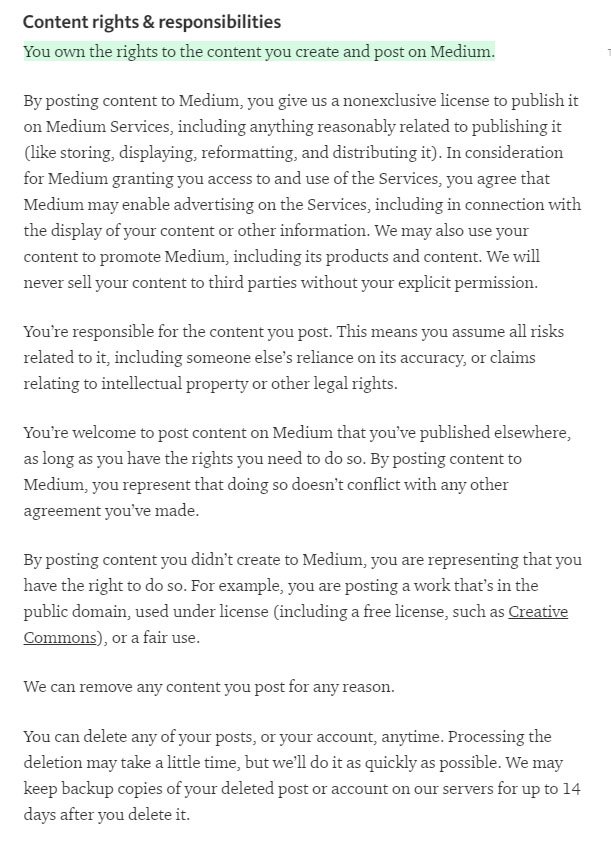
Taking this approach has two advantages.
First, it encourages users to supply content.
Medium offers an extensive platform for creative works that may not exist if authors do not retain their copyright ownership. However, if Medium wishes to promote material or use it for its own purposes, the Terms of Service grants that right.
Second, it is less work on your part.
It is difficult enough to protect your own intellectual property rights without also having to check for plagiarism of UGC. Copyright protection remains with the user and as long as you use your license appropriately, you cannot be held responsible for infringement or failure to protect UGC.
Besides adding licensing language like that in the Medium agreement, also make your intellectual property interests clear. A statement in your Terms & Conditions like that of Meetup can satisfy that need:

The takeaway from this is to protect your own intellectual property in your Terms & Conditions. But for UGC, limit it to a license. Do not unintentionally take responsibility for your users' copyright interests.
Infringement
Websites are vulnerable. One "save as" right-click on an image or cut and paste on text may infringe on your material. This is likely a "when" it happens, not an "if" it happens, so you should be prepared to face possible infringement.
The first step when you experience infringement is usually to send a cease and desist letter. You can find templates online that instruct the infringing party to stop using your material or face penalties. You can do this even if your copyright is not registered.
If there is no response to the cease and desist letter and your material remains on the other website, register your copyright in your jurisdiction as soon as possible (if that is offered). This offers possible statutory relief that is not available for unregistered copyrights. Since you secure this protection when your website is launched, the date of registration normally does not matter.
Another course of action is the DMCA takedown notice. The U.S. Digital Millennium Copyright Act (DMCA) places infringement liability on websites that may unintentionally post and distribute protected material without permission. Developers avoid this liability by offering copyright owners a system for requesting that their material is taken down.
If you find your material on an unauthorized website, look for their DMCA provisions in their Terms & Conditions. You should find instructions on filing a DMCA dispute. File one.
Here is an example of tumblr's DMCA provisions so you know what to look for if you find yourself in this situation. Notice links to online forms so you can file these complaints efficiently:
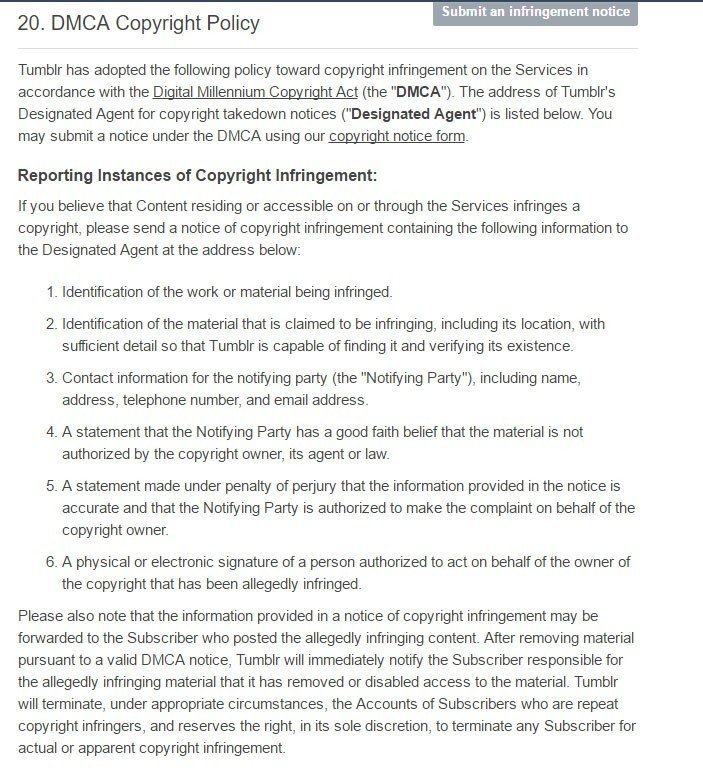
Likewise, if your website includes user-generated content, make sure you have similar provisions in your Terms & Conditions. Otherwise, you risk facing a copyright infringement action.
Fair Use
There is one exception to copyright infringement and that is fair use. Not to be confused with "free use" it is the limited and reasonable use of copyrighted material that does not interfere with an owner's rights.
Fair use is appropriate for public benefit purposes, like research and information. Parodies also fall under this exception as well as any comment or critique.
The most common online example of fair use is product reviews. If a website reviews a book, appliance or any other consumer product, it often needs an image. A picture of the item or the book cover is vital for completing the review. This does not require permission from the copyright owner.
It is important to ascertain the use of your content before launching into accusations of infringement. You may find negative reviews or fail to enjoy a particular parody of your game or video content. Unfortunately, this use of your intellectual property is not actionable and you must find a way to tolerate this.
The ability to protect your website from infringement is vital in this free and open online world. You work hard to create content, whether it includes text, graphics, photographs or video. Take advantage of any registration process your country has to offer to assure your intellectual property remains firmly in your possession.
Webpage Copyright Protection FAQ
What is a copyright?
Copyright is a form of protection that applies to original creative works, like literary, dramatic, and artistic expression. This includes all forms of creation including text, film, graphic, and websites.
Does copyright protection extend to my website?
Yes. Websites contain all the elements of other creative works. It may be graphic and text based or contain an involved online game. No matter how simple or complex, it is entitled to copyright protection.
Do I need to register every component of my website separately?
You can register your website as one work as soon as it is developed. Your initial registration covers all material posted at the time--page content, graphics, videos, and current blog entries.
However, if you add blog articles, new graphics or an additional feature, you will need to file new registration forms for that content. Under U.S. copyright law, you may qualify as a serial or newsletter which allows you to register in three-month chunks to cover all the material you produce during that time. Canada has a similar process. That allows you to create continuously without having to constantly file forms.
Does my website need a notice to be protected?
No. A notice like "©2017 Web Developer" is more habit than requirement. Most developers add one as a reminder to users and to feel safer in the online world. Even if you forget to include this notice, you are still entitled to copyright protection.
What are the relevant laws?
Copyright protection is secured under the laws of the country you seek protection. Relevant laws may include:
- Copyright Act of 1976 (U.S.)
- Copyright, Designs, and Patents Act 1988 (U.K.)
- Copyright (Computer Programs) Regulations 1992 (U.K.)
- Copyright Act 1968 (Australia)
- Copyright Act (Canada)
All of these countries have a registration process except for Australia. Copyright disputes there must be settled through civil action.
How do I secure this protection?
Primarily, you create an original work of art - in this case, a web page. It becomes a protected, copyrighted work upon its completion and release to the public.
If you want additional legal protection, registering your copyright allows additional remedies if you face infringement. Generally, registration involves a database search, an application, payment of a fee, and then, waiting for the relevant copyright office to alert you to their decision. While this seems stressful, be aware that most copyright applications are approved and that it can be well worth the process to get your registration.
I am building a website in the United Kingdom. Do I have copyright protection in the United States?
There is no international copyright registration system, but international conventions allow protection across borders.
The U.K. and U.S. are both members of the Berne Convention, so if you created a website in the U.K., that protection extends to the U.S. That is because these countries agreed to protect each other's' citizens from copyright infringement through that treaty. The same will apply to other contracting states in the Berne Convention--you will enjoy extended protection in France, Australia, Canada, and even Gambia as well.
The same privilege is available with the Universal Copyright Convention (UCC), a treaty managed by the UN. There is overlap in memberships between the Berne Convention and UCC which adds an additional layer of international protection.
You can also take advantage of the guidance of the World Intellectual Property Organization (WIPO). That organization manages the Berne Convention. WIPO also offers searchable databases and dispute resolution if you discover infringement on an international level.
Are there exceptions to copyright protection?
Yes. The doctrine of fair use is the most common exception. Often analyzed in terms of public benefit, using copyrighted material for parody, comment or criticism is not considered infringement. If you find screen caps of your online game in a review or parts of your website quoted in a discussion of your services, you will not have remedies under copyright law in any jurisdiction.
I hate forms! Why should I bother registering?
In the U.S., registering your copyright assures you can collect statutory damages if your claim is successful. In other countries, it is solid proof that you own the copyright and that also expands your civil remedies.
If your copyright is not registered, you may be limited to cease and desist letters, injunctive relief (stopping the infringement), and rights and procedures authorized by the Digital Millennium Copyright Act (DMCA, U.S. law). These actions stop the infringement, but if you lost profit or goodwill due to the infringement, you will not be able to collect additional damages.
The registration process is fairly easy and inexpensive. Most website developers find the effort well worth it.
Someone copied my web page content! Now what do I do?
Start with a cease and desist letter. This explains your ownership of the copyrighted material and gives notice of infringement. The offender either has to quit using your material or possibly face further penalties in civil court.
If you have not registered your material yet, finish that process if it is available where you live. Even though you register after-the-fact, it will not matter since you received protection when you created the material. Registration just allows you more remedies.
If you find the material on another website, you can send the website a Digital Millennium Copyright Act takedown notice. This does not allow you to collect damages but it will stop the infringement of your material.

Comprehensive compliance starts with a Privacy Policy.
Comply with the law with our agreements, policies, and consent banners. Everything is included.
